The 360° IP Approach
The approach presented here is based on the pioneering work of Prof. Dr. A. J. Wurzer and his colleagues T. Grünewald and W. Berres. The underlying work (in which I myself was not involved) can be obtained directly from the publisher here.
I have further developed this methodology together with the authors over the last few years and successfully introduced it in companies. My contribution was to make this somewhat academic approach a little more practical, to optimise its introduction into companies and, by combining it with DIN 77006, to ensure that this strategy is not just a flash in the pan, but is implemented in the long term, thus securing the economic success of a company in the long run.
My contribution


Without any protection (patents, trademarks, designs), you will probably start with a moderate price, which will erode very quickly as soon as imitators enter the market. They have an easy job because they only have to copy your product 1:1 and are therefore significantly cheaper than you because they had no development costs. The only thing left is to compete on price.
With some form of protection (classic IP strategy), you start at a higher price point and can benefit from it for longer because 1:1 replication is not possible. At least in some aspects, workarounds must be found and developed before a free rider can enter the market.
The 360° IP strategy approach proposed here makes it possible to maintain the price premium for as long as possible, ideally for twenty years, which is the maximum term of patents.
Your economic effect


A simple example from the field of printer technology illustrates why the business case is so essential to IP strategy:
An engineer will focus the patents on his most innovative features, which he has developed at great expense. If the business case works just as well without these features, it doesn't make much sense. The product manager for office printers earns his money from maintenance contracts. So he needs protection for robustness and ease of maintenance. The product manager for home printers, on the other hand, relies on the long-term supply of original cartridges and needs protection for the compatibility of printers and cartridges.
As you can see, depending on the business case, the focus is on completely different aspects, and the degree of technical innovation is secondary. This is where the 360° IP strategy comes in.
Focus on the business case


Controlling risks, i.e. systematically monitoring competitors' intellectual property rights, is the first (and most important) building block. Why? First, I have to make sure that I am allowed to sell my product at all before I worry about whether someone is copying me.
Suppressing imitation represents the classic IP approach of basing patents on individual (innovative) features. This does help to a certain extent against 1:1 copies, but they can still be easily (or more easily) circumvented.
Creating exclusivity is at the heart of the 360° IP strategy: there is a shift in thinking away from the question ‘What have I developed?’ to the question ‘What don't I want to see on the market?’. This is where, for the first time ever in the IP world, the customer himself comes into play: What does he actually want? What is he willing to pay for? etc. This means that you need much more comprehensive patent protection for your products, which may also cover aspects that you may not want to realise yourself, but which you also do not want a competitor to recognise and thus potentially damage your innovative image.
Last but not least: communicating exclusivity. If you have such exclusivity, you should also use it effectively in your marketing. This is where IP and sales work hand in hand.
The 360° IP approach in a nutshell
Dr.-Ing. Martin Bookjans
© 2025. All rights reserved.




